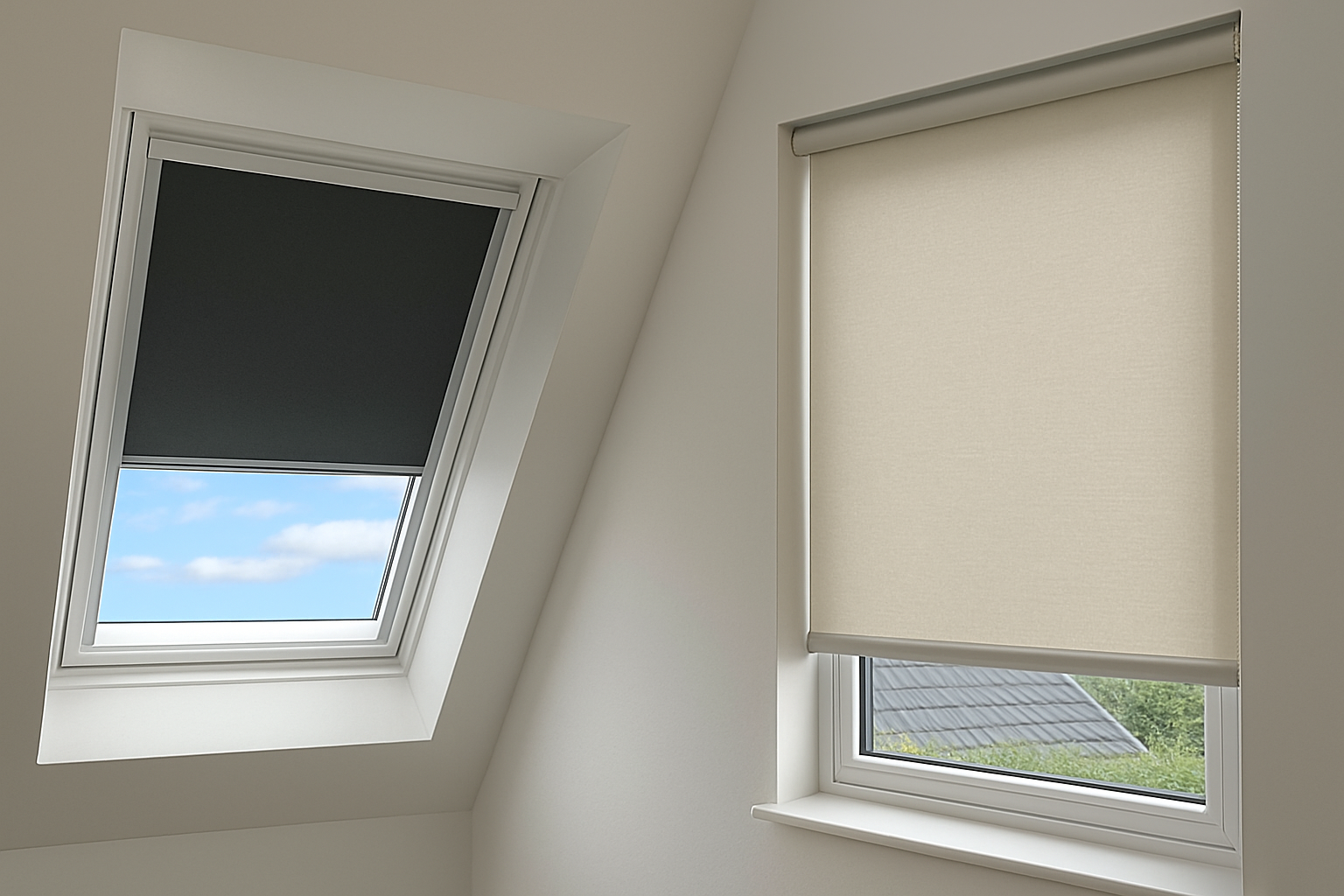Understanding the Basics: What Are Velux and Roller Blinds?
Choosing between Velux and roller blinds begins with understanding what each type is designed for. Velux blinds are custom-fitted solutions made specifically for Velux roof windows, while roller blinds are versatile fabric blinds that roll up and down using a cord or spring mechanism, suitable for standard windows.
Velux blinds are tailored for skylights and roof windows, offering optimal fit, insulation, and light control for hard-to-reach locations. They’re ideal if your home has loft conversions or a lot of natural overhead light. Available in options like blackout, light-dimming, and solar-powered versions, Velux blinds deliver functionality with form. On the other hand, roller blinds are more widespread, available in countless colours, patterns, and fabrics. They’re a great choice for traditional window settings and rooms where you want something simple yet stylish.
Both types have their merits based on where and how you plan to use them. Velux blinds are highly specialised and efficient for angled windows. Roller blinds are adaptable, budget-friendly, and easy to coordinate with other décor elements. Before making a final decision, understanding their core design and use cases lays the groundwork for a more informed purchase.
Light Control and Insulation
Light filtering is a critical factor when choosing between Velux and roller blinds. Velux blinds, due to their custom fit, offer superior light control and are typically more effective at blocking out daylight. Many models, especially blackout options, are designed to eliminate light bleed completely — a vital feature if your windows are overhead or in a bedroom.
Additionally, Velux blinds contribute greatly to insulation and energy efficiency. Their tight seal helps maintain a stable room temperature, preventing excess heat during summer and retaining warmth in winter. This can potentially reduce energy bills over time. Velux also offers thermal blinds with built-in insulation layers, ideal for homes in colder regions or with significant exposure to sunlight throughout the day.
Roller blinds can also offer good light control, depending on the fabric you choose. Blackout fabrics reduce most light, but they might not offer a complete seal like Velux blinds do, especially around the edges. Light-filtering and dim-out fabrics are better suited to living rooms or kitchens where some natural light is still desired.
In terms of insulation, roller blinds don’t typically offer the same degree of thermal efficiency unless equipped with specific lining or advanced materials. Though some modern roller blinds are designed to reflect heat, they lack the tight fit Velux blinds provide. Still, they offer reasonable energy conservation when appropriately chosen and installed, especially for standard vertical or horizontal windows.
Installation and Compatibility
How easily a blind can be installed and whether it will fit your window can be a huge deciding factor. Velux blinds are manufactured to perfectly match specific Velux window codes, making installation a breeze. Most models come with a straightforward installation system that doesn’t require cutting or adjusting the blinds to size.
This compatibility is ideal for homeowners who want a professional, faultless look without the fuss of complex fitting. Once you identify your Velux window code — usually found on a plate on the window frame — you can select matching blinds for a guaranteed fit every time. Some Velux blinds even come with manual or remote control options, adding convenience, especially for hard-to-reach skylights.
Roller blinds, in contrast, involve a bit more measuring and trimming, unless they’re made to measure. While fitting them isn’t particularly difficult, achieving a perfect edge-to-edge fit can be more challenging, especially on unusually shaped or recessed windows. This becomes even more evident in older properties where window dimensions may vary.
Custom-made roller blinds are a great way to resolve fitting issues, although that may increase the cost. If you’re planning to install roller blinds across multiple rooms or properties, be ready to spend some time measuring and selecting fabric and fittings individually for each window.
Style and Design Options
If interior aesthetics are a major concern, the choice between Velux and roller blinds should be approached with your design vision in mind. Velux blinds are sleek and minimal, with a focus on functionality. They fit snugly within the window frame, giving a streamlined, professional appearance. While the choice of colours and styles is more limited compared to roller blinds, Velux still offers a range of options including bold colours and printed patterns — enough to coordinate with most modern interior styles.
Roller blinds shine when it comes to customisation and style. Available in thousands of colours, textures, and prints, they offer unmatched diversity. From solid neutral shades to floral prints and geometric patterns, roller blinds are a designer’s playground. You can even choose from transparent, semi-opaque, or blackout fabrics depending on your lighting needs and privacy preferences.
Even better, roller blinds can be paired with decorative elements like scalloped hems, pelmets, and pulls to add a distinctive touch to your décor. This level of personalisation makes them ideal for living rooms, bedrooms, and kitchens. Whether you’re aiming for a minimalist Scandinavian theme or bold contemporary designs, there’s a roller blind for every taste.
For roof windows, however, roller blinds may fall short in terms of final finish and utility. They might not sit flush or operate smoothly on angled surfaces, which is where Velux blinds have a clear edge. But for ease of matching your blinds to your furniture and wall colour, roller blinds offer far greater creative flexibility.
Suitability for Different Rooms
Each blind type shines in specific settings, so determining which one to go with often depends on where it’s being installed. Here’s a general breakdown:
- Velux Blinds: Best suited for loft conversions, skylights, and any sloping roof windows. They are ideal for bedrooms, attics, and bathrooms where overhead light needs to be controlled effectively.
- Roller Blinds: Perfect for living rooms, dining rooms, kitchens, and standard bedrooms. Their flexibility in style and fabric makes them a great all-rounder.
If you’re fitting blinds in a conservatory or sunroom, roller blinds can still be a strong choice, especially if paired with thermal or solar-reflective fabric. For a more tailored solution, you could explore conservatory blinds which are custom-designed for such spaces and offer both aesthetic and climate-control advantages.
Velux blinds outperform in areas prone to excessive sunlight or where privacy at height is crucial. Their fuss-free mechanism and precise fit make them highly suitable for children’s rooms or home offices located in converted attic spaces. The blackout versions are particularly useful for those who work night shifts or require complete darkness during the day.
That said, versatility remains the stronghold of roller blinds. If your home has multiple window types or interior design themes, roller blinds provide the advantage of being tailored uniquely for each space. Whether you opt for minimal modernism or vintage warmth, there’s a roller blind that fits the purpose and style.
Cleaning and Maintenance
Cleaning and maintaining your window blinds can have a direct impact on their longevity and continued aesthetic appeal. Velux blinds, due to their strong build quality and fixed frame design, are relatively low-maintenance. Most dust can be wiped off using a soft cloth or cleaned using a vacuum with a brush attachment. Since these are usually out of reach, they tend to accumulate less dirt compared to standard window coverings.
The fabric and mechanics on Velux blinds are made to endure exposure to sunlight, so they maintain their appearance longer without fading. However, certain types like pleated or blackout models might require occasional checks for wear or debris in the runners. Special attention should be given if you’ve selected manual or solar-powered versions, ensuring the control system functions properly over time.
Roller blinds are easy to clean too, especially those made from PVC or polyester materials. A damp cloth and mild detergent are generally enough. Fabric variations, especially decorative or textured options, may need a more careful hand to avoid damage or discolouration. Homeowners with pets or children may need to clean roller blinds more frequently to maintain hygiene and appearance.
One downside of roller blinds is the possibility of fraying edges or fading fabrics over time, particularly if exposed to strong UV rays. Maintenance can also vary based on the type of roller mechanism used — spring-loaded rollers might lose tension, while chain-operated ones require periodic checks for tangle or slack. Nevertheless, simple repairs or replacements are usually manageable without professional help.
Cost and Value for Money
Cost is often the deciding factor when choosing between window blinds. On the surface, roller blinds are generally more affordable, making them accessible for all budgets. With prices starting low and a wide range of fabrics available, you can easily kit out an entire home without breaking the bank.
In contrast, Velux blinds tend to sit in a higher price bracket since they’re tailored for specific window models, often requiring premium materials and specialised fittings. However, they’re an investment in long-term value. Their durability, energy-saving capabilities, and precise light control can translate into future savings on heating, cooling, and even sleep quality in bedrooms or nurseries.
If you’re choosing blinds for standard window configurations and want maximum style for minimum spend, roller blinds



